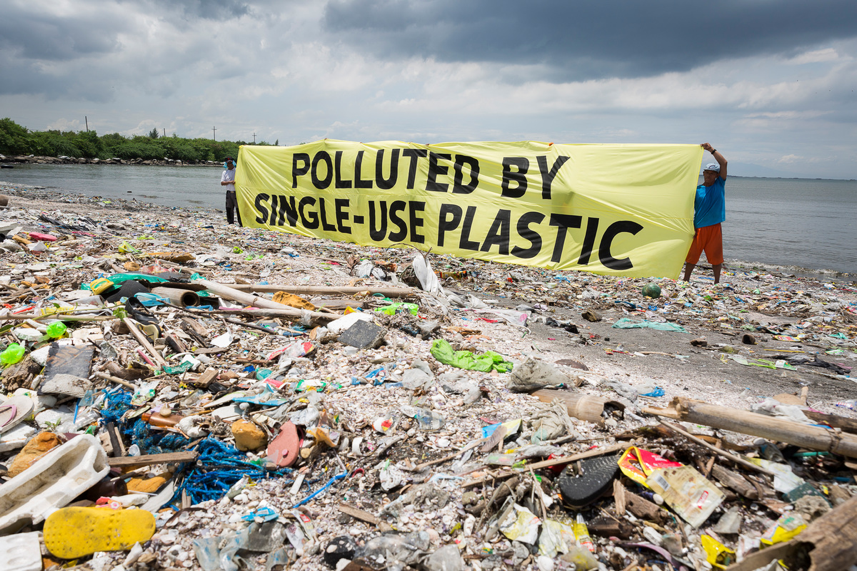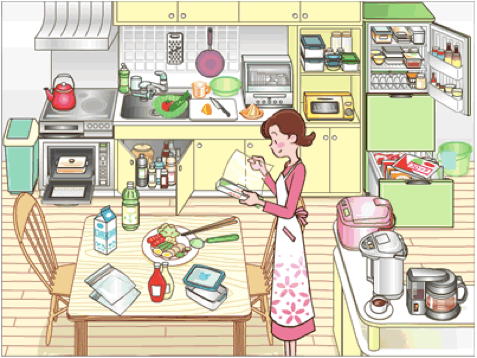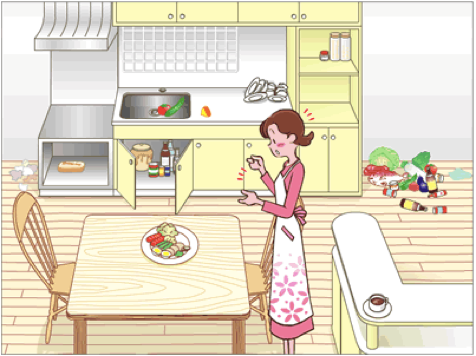
Greenpeace’s activists are at the forefront of the fight against plastic Credits: Greenpeace
As we all embrace a slower lifestyle, we are presented with an opportunity to challenge ourselves and rethink our consumption patterns. When it comes to fighting plastic pollution, we individuals have more power than we think, argues Fabien Cadez.
Over the last two decades the public has grown more and more aware of plastic pollution. According to a study published by the University of California, 6.3 billion tons of plastic waste has been generated as of 2015, out of which 79% has ended up in landfills or the environment. 12% has been burned, and only 9% has been recycled1. The media, NGOs and consumers frequently denounce the urgency of the problem, holding Fast-Moving Consumer Goods (FMCG) companies and plastic producers responsible for this scourge. As a result, the exerted pressure pushes companies across the value chain to be mindful towards environmental protection and provide sustainable products on the market. However, the debate on plastic pollution often appears tainted by simplistic views regarding the nature of plastics and recycling, dubious assumptions on the “ecological packaging” and an overemphasis towards the responsibility of retail and FMCG companies – as well as plastic producers for this issue. Ultimately, if we want to fight plastic pollution effectively, we should question our own consumption behavior and keep in mind that we, as individuals, have a strong power. That power lies in our choices, as consumers, to buy plastics or not, and in our choices as citizen to support a green political agenda.
The challenge of responsible packaging behind plastic pollution
Contrary to popular belief, plastics are not just one material. It is a broad category incorporating a wide variety of polymers with diverse properties designed to meet the needs of different applications. In the case of plastic pollution, it represents a complex issue involving a wide range of consumer and industrial goods discharged into the environment, mostly after a single use. In 2015, packaging accounted for the largest segment of primary plastic production worldwide with 146 out of 407 millions of tons, while having generated 46% of all plastic waste the same year2. As it is often associated with consumables, FMCG companies and their packaging suppliers bear an important responsibility. However, the problem is that a vast majority of current packaging structures are designed for single use only, and very often combine multiple layers of various polymers (and even sometimes aluminum). Each layer has certain properties to respond to specific packing needs such as product freshness, heat resistance, transparency, and so on. As such, this type of multi-material structures mostly explains the technical challenges behind recyclability. As an example, a stand-up bag for coffee commonly uses a 3-ply structure of PET/ALU/PE3 , whereas current technologies are neither capable of recycling such multi-layer structures nor dissociating each of the laminated layer to recycle them independently. For the time being, mostly PET bottles and aluminum-related containers are suitable for recycling, on account of the chemical composition of these materials and the mono-material structure used to make such containers4.
The problem is that a vast majority of current packaging structures are designed for single use only, and very often combine multiple layers of various polymers
Alternatively, we must be wary of so-called “ecological packaging”. Firstly, a lot of the supposedly sustainable packaging is not as environmentally-friendly as it looks. It is sometimes brownish paper-based laminates coated with plastic layers, and therefore cannot be recycled5. Secondly, the term « bioplastics packaging » hides a broad range of products made of renewable biomass sources and biodegradable fossil-fuel. Be careful with bio-based packaging, though – it may be made from sugar cane, corn or potatoes, which does not mean it is automatically decomposable; sometimes it is biodegradable under certain conditions but sometimes it is simply not6. Although such packaging might appeal to eco-conscious consumers, various eco-audits and studies demonstrated that, at the time being, it is not necessarily better for the environment than the conventional one7. Likewise, biodegradable packaging from both renewable or fossil-fuel sources often causes as much harm by ending up in the ocean and breaking down into microplastics, as it does not meet the right conditions to dissolve effectively8. The improvement of packaging from renewable sources may indeed provide viable alternatives in the long term9, but it still is expensive in comparison and falls below performance requirements10.
Inside the packaging industry
That being said, the status quo is not an option. Several governments around the world have already enacted a ban against single-used plastic. With swelling socio-environmental claims and now growing regulatory pressure. During the 2018 World Economic Forum, a prominent manufacturer committed to make all packaging recyclable or reusable by 2025. Inside the industry, this implies allocating financial and human resources to the research and development of new mono-material structures made of polyolefin (PE)11. However, this process is considerably more complex and involves multifaceted challenges and constraints, that only time and efforts will solve. R&D engineers must indeed work closely with their retail and FMCG customers to come up with new structures made of a single material, which requires to have equivalent proprieties along with similar efficiency and price regarding multi-layer structures. In some cases, there are also operational issues associated with the processability and qualifications of new specifications onto customers’ machines. But once these challenges are overcome and the promise is kept, will consumers/citizens take their responsibilities and recycle all plastic packaging waste?
A utopian post-plastics society
Despite the slow, yet beneficial, changes happening in the packaging industry, a fringe of the society wishes to fully eliminate plastics from the daily life of human societies. Although full of good intentions, radical activists pushing for bold moves underestimate its presence in our daily life: non-packaging plastics represent 56% of primary plastic production and can be found in a wide range of goods such as clothing, smartphones, flooring and industrial components, among tons of others12. In some industrial and technical markets, plastics are even paradoxically contributing to the emergence of innovative and environmentally-friendly products: thin plastic laminates now progressively replace glass to encapsulate photovoltaic panels, increasing modular flexibility and thus its scope of applications; fluorine-based plastic is increasingly used in modern architecture for facades and roofs, praised for its light transmission, durability, light weight and design flexibility; windows spacers made from an insulating plastic composite material are improving thermal insulation in buildings; you name it. Above and beyond, a utopian post-plastics society would require new revolutions in material science along with a realistic transitional place to redirect and absorb a considerable mass of labor associated with this industry – knowing that in the EU alone, 1.5 million jobs depend on it13.

Credits: polyplastics

Credits: polyplastics
How about washing our hands before pointing fingers?
At the end of the day, the companies we blame for all ills of this world, depend on us, as consumers, to sell their products. Therefore, a big chunk of the responsibility lies on our side. As a matter of fact, Europe had the second biggest plastic consumption per capita with 70kg/person in 2015 behind North America14. In the same year, the average citizen generated 31kg of plastic packaging waste15. Sadly, the dustbin is not a black hole and our plastic waste frequently ends up being burned or dumped in landfills or the environment. To highlight the global impact of our actions, we have transferred this burden onto lower-income countries for many years by exporting plastic pollution mostly to Asia, China being the most significant export destination until it put a ban in 201616. Therefore, we should criticize ourselves first and be mindful about the amount of plastics we use and buy in supermarkets and retail stores.
Of course, there is room for improvement for other stakeholders as well. Even with the best intentions from citizens and available recyclable packaging , it wouldn’t be very useful without collecting, sorting and recycling facilities. Among developed economies, the European Union and Japan are the only places with a regulatory framework encouraging plastic recycling along with good infrastructural networks. In 2017, the EU Member States recycled an average of 42% of plastic packaging waste17. However, countries like the US or Australia still rely too heavily on old-fashioned methods like landfill and incineration, thus less than 10% is being recycled locally, while rates are close to 0%18 in the rest of the world… Again, what we can do as individuals is support political parties and lobbies with a green agenda. They will pressure local governments in order to implement a strong waste management policy and allocate a bigger share of the national budget to the necessary infrastructures.
Butterfly effect: in the power of committed individual actions we trust
Being a responsible citizen and recycling plastic packaging waste is good, but avoiding its consumption in the first place is even better. In recent years, it has become increasingly trendy to lead a “plastic-free” lifestyle using various methods such as shopping with reusable bags, carrying glass water bottles and eco-friendly utensils around or buying sustainable clothing made out of natural fibers – the list goes on! Those with free time can even produce their own variety of home-made products like yogurts, deodorants, shampoo or condiments19. Otherwise, zero-packaging food stores have emerged around various countries as serious alternatives for eco-friendly consumers. They propose food, household and beauty care products, all purchased by clients using their reusable containers. As an Australian newspaper reports, this type of stores brings other benefits to society: “Zero-packaging stores encourage sourcing locally. They can therefore play an important role in enhancing local economy and supporting local producers. They can help break globalized agribusiness monopolies, regenerating the diversity of rural enterprises and communities”20. Nevertheless, the price of products in such retailers is often way higher in comparison with traditional supermarkets and is likely to discourage lower-income strata from purchasing. Perhaps the most enterprising individuals of us should join the movement and find creative ways to supply affordable products for everyone?
At the end of the day, blaming certain stakeholders means denying the power we, the consumers, have in our hands: we can refuse to buy certain products because of their unwanted packaging. Each time we undertake such steps will be a victory against plastic pollution and generate a chain reaction. Thanks to the sum of these individual actions, the demand for certain products will drop, impacting foremost retail and FMCG companies and then their suppliers of plastic packaging. These firms will realize the decline comes from shifting purchasing preferences of ecologically-conscious customers. Therefore, retailers will be forced to sell products without plastic packaging if they wants to remain on the market. At the same time, their own demand for plastic packaging will decline, thus putting pressure on their suppliers’ revenues. In turn, packaging manufacturers will have to move into producing higher added value products for industrial and technical markets where plastics are actually needed and can help make a real difference. In all cases, it is true that we must hold manufacturers across the value chain accountable for their operations, and pressure them towards corporate social responsibilities commitment. But we also have to refuse falling into the trap of simplism and finger pointing; let’s put our trust in the power of committed individual actions above all.
1. BBC News. (2017). Seven charts that explain plastic pollution problem. Retrieved from: https://www.bbc.com/news/science-environment-42264788
2. Ritchie, H. & Roser, M. (2018). Plastic Pollution. Retrieved from: https://ourworldindata.org/plastic-pollution
3. Polyethylene Terephthalate (PET)/ Aluminium (ALU) / Polyethylene (PE)
4. Cuffari, B. (2016). What are the Most Recyclable Materials? Retrieved from: https://www.azocleantech.com/article.aspx?ArticleID=585
5. For smokers, the example of rolling tobacco packs from Parisienne Authentique is one of them.
6. Therefore, this type of packaging should always be properly disposed in an appropriate bin.
Barrett, A. (2019). Are Biodegradable Plastics the Answer to Ocean Plastic Pollution? Retrieved from: https://bioplasticsnews.com/2019/02/26/are-biodegradable-plastics-the-answer-to-ocean-plastic-pollution/
7. Hischier, R. (2014). Ökobilanz von Tragetaschen. Retrieved from: https://www.actions-not-words.ch/content/dam/act/TatenstattWorte_Relaunch/Nachhaltigkeitsthemen/Umweltschutz/Verpackung/coop-haltung-bioplastics_en.pdf
8. UN Environment Program. (2015). Biodegradable Plastics Are Not the Answer to Reducing Marine Litter, Says UN. Retrieved from: https://www.unenvironment.org/news-and-stories/story/biodegradable-plastics-are-not-answer-reducing-marine-litter-says-un
9. Sykes, T. (2018). 2018 Finalists in the ‘Bio-Based’ Category. Retrieved from: https://packagingeurope.com/bio-based-finalists-sustainability-awards-2018/
10. -van Crevel, R. (2016). Bio-based food packaging in Sustainable Development. p.45. Retrieved from: http://www.fao.org/forestry/45849-023667e93ce5f79f4df3c74688c2067cc.pdf
-Stöter, D. (2020). Biolplastics for Packaging – More Sustainable than Plastic? Retrieved from: https://www.euroshop-tradefair.com/en/.mag/Bioplastics_for_Packaging_–_More_Sustainable_than_Plastic
11. Polyolefin is a material praised for being recyclable and having good performance, barrier protection and heat resistance.
12. Ritchie, H. & Roser, M. (2018). Plastic Pollution. Retrieved from: https://ourworldindata.org/plastic-pollution
13. Plastics Europe. (2017). Plastics – the Facts 2017. Retrieved from: https://www.plasticseurope.org/application/files/5715/1717/4180/Plastics_the_facts_2017_FINAL_for_website_one_page.pdf
14. Euromap. (2016). Plastics Resin Production and Consumption in 63 Countries Worldwide 2009-2020. Retrieved from: http://www.pagder.org/images/files/euromappreview.pdf
15. World Economic Forum. (2018). These European countries produce the most plastic waste per person. Retrieved from: https://www.weforum.org/agenda/2018/04/european-countries-most-plastic-waste-per-person/
16. National Geographic. (2016). Plastic Recycling Is Broken. Here’s How to Fix It. Retrieved from: https://www.nationalgeographic.com/news/2018/06/china-plastic-recycling-ban-solutions-science-environment/
17. Eurostat. (2019). How much plastic packaging waste do we recycle?. Retrieved from: https://ec.europa.eu/eurostat/web/products-eurostat-news/-/DDN-20191105-2
18. d’Ambrières, W. (2019). Plastics recycling worldwide: current overview and desirable changes. Retrieved from: https://journals.openedition.org/factsreports/5102
19. Terry, B. (2007). 100 Steps to a Plastic-Free Life. Retrieved from: https://myplasticfreelife.com/plasticfreeguide/
20. The Conversation. (2019). Recycling is not enough. Zero-packaging stores show we can kick our plastic addiction. Retrieved from: https://theconversation.com/recycling-is-not-enough-zero-packaging-stores-show-we-can-kick-our-plastic-addiction-106357




In connection with your article, french visual artist, I drew a series on ocean pollution made from photographs of plastic…